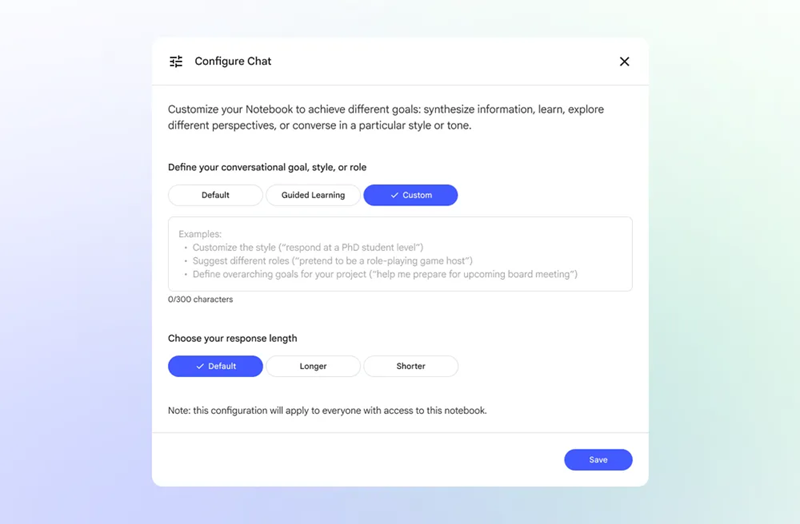- Google updated NotebookLM to a million-token context window, allowing AI to analyze entire books or massive project files in a single chat.
- The update also increases NotebookLM’s memory storage sixfold, laying the groundwork for new memory features like a saved conversation history.
- NotebookLM’s improved flexibility means it can take on all types of personas and uses the new ‘Goals’ system, which allows users to define the role of the AI.
NotebookLM is no longer just for footnotes. Google’s ambitious research assistant has just moved beyond its academic roots and into more comprehensive conversational collaboration.
Google has announced a broad set of updates designed to improve NotebookLM’s ability to mimic human understanding of circumstances and appropriate interactions.
The updates are made possible by a massive expansion of NotebookLM’s context window, essentially its short-term memory. NotebookLM now supports the full Gemini context window of one million tokens on all plans.
It is more than double what was previously available, and this means that AI can now hold entire books, long meeting transcripts, and extensive project files in its virtual mind for immediate collection and analysis at once. It’s a big leap for users who juggle large collections of documents and want more than superficial answers.
You will no longer have to copy and paste fragments of a PDF into a chatbox. You can upload it in its entirety, along with any supporting documents, emails, or notes you want to add, and NotebookLM will not only read it all, but also refer to it in long, coherent conversations. It’s the difference between talking to a helpful stranger and working with someone who’s been in the project trenches with you since day one.
Improved answers
And the reward is very real, according to Google. The company claims that internal testing shows a 50% improvement in user satisfaction for longer, multi-source responses, thanks to this increase in attention span.
The memory improvement also applies to conversations with users. While you may have noticed that NotebookLM loses its train of thought after you’ve sent just a few messages, it can now track context six more times in a dialogue.
NotebookLM will also keep your chat history top of mind, for lack of a better term. That means you can start a session on Tuesday, close your laptop, and pick up the same train of thought on Friday afternoon without retracing your steps. That memory also remains private. Shared notebooks don’t share chats unless you want them to.
google goals
What ties all of these updates together is the addition of ‘Targets’, essentially a way to set how the AI assistant approaches and interacts with you. You can ask for a virtual dissertation advisor who finds gaps in your logic, or a sounding board for a new script that answers every question with another question to encourage thinking. You can even ask him to take on a guiding role through the fiction, acting as a game master in tabletop role-playing games and “improvising” a complex narrative.
NotebookLM is based on using AI not to search all the time, but to provide information about the research you have already done. The platform does exactly that, which is helpful as AI tools become more ubiquitous in the workplace (overtly or not).

The flexibility of NotebookLM’s goal and personality settings makes this even more obvious. You’re no longer adjusting pitch on the fly. You are setting parameters for how this wizard should think. These changes push NotebookLM into the realm of platforms like Notion AI. You can also see Google opting for a custom agent that allows ChatGPT’s memory, or Perplexity’s multimodal options that can absorb multiple documents at once. But NotebookLM stands out for how well it merges those features into a single interface, something Google often succeeds at.
There’s also a distinctly Google-flavored logic at play. Integrations now span over a million apps and websites. The chat interface coordinates things between those applications. So while NotebookLM can’t imitate the semi-independent digital agents emerging from AI vendors, the groundwork is being laid.
The new version of NotebookLM could be the kind of tool that appeals to those who currently distrust AI but fear document analysis. Arguably, what most people want from AI is a tool whose function is shown through its form, not a black box that you can’t understand. NotebookLM could fill that niche.
The updates make it easier for NotebookLM to serve more people. It can offer better study guides for students, better citation management, and better cross-referencing. NotebookLM learns how you work, remembers what you’re doing, and meets you along the way. And that’s a statement that’s much easier to trust than those that say “transform the way you work.”
Follow TechRadar on Google News and add us as a preferred source to receive news, reviews and opinions from our experts in your feeds. Be sure to click the Follow button!
And of course you can also follow TechRadar on TikTok for news, reviews, unboxings in video form and receive regular updates from us on WhatsApp also.

The best business laptops for every budget



